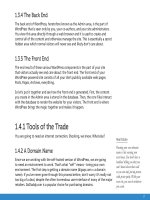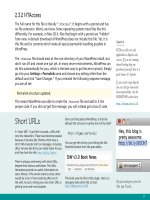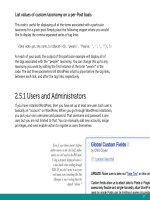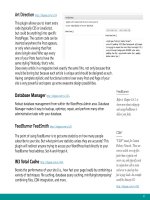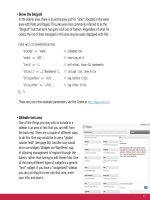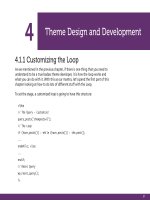Tìm Hiểu về Wordpress - part 2 ppsx
Bạn đang xem bản rút gọn của tài liệu. Xem và tải ngay bản đầy đủ của tài liệu tại đây (334.13 KB, 10 trang )
4.7.1 Using Multiple Themes 123
4.8.1 Widgetizing 126
5 Extending Functionality
5.1.1 Extensibility 131
5.1.2 Extending WordPress with Plugins 131
5.1.3 A Plugin for (Almost) Everything 131
5.1.4 Do You Need a Plugin? 135
5.1.5 Choosing the Perfect Plugin 136
5.2.1 Plugin Usage and Maintenance 138
5.2.2 Sequential Installation 138
5.2.3 Keep Plugins Up-To-Date 138
5.2.4 Subscribe to Plugin Comment Threads 139
5.2.5 Getting Help with Plugins 140
5.2.6 Diagnosing Plugin Conflicts 140
5.2.7 Disabling and Uninstalling Plugins 141
5.3.1 Extending with Custom Functions 144
5.3.2 Plugins vs. Theme Functions (via functions.php) 145
5.3.3 Useful Examples of Theme Functions 146
5.3.4 Example #1: Easy Admin Buttons for Comments 146
5.3.5 Example #2: Sitewide Shortcode Functionality 147
5.3.6 Example #3: Transferring Plugins to functions.php 149
5.3.7 Example #4: Transferring Functions to a Plugin 150
5.4.1 Other Ways to Extend Functionality 151
5.4.2 Functions Within Theme Files 151
5.4.3 Hacking the WordPress Core 153
5.5.1 WordPress as a CMS 154
5.5.2 CMS Features Built Into WordPress 154
5.5.3 Working With Custom Fields 155
5.5.4 Users, Roles and Permissions 160
5.5.5 Categorizing, Tagging, and Custom Taxonomies 161
5.5.6 Page Templates 162
5.5.7 Page, Category, and Tag Hierarchies 163
5.5.8 Dynamic Menus 165
5.6.1 Extending CMS Functionality 166
5.6.2 CMS-Related Plugins 166
5.6.3 Using WordPress as a Forum 171
5.6.4 Integration with Third-Party Forum Applications 172
5.6.5 Multiple Blogs with WordPress MU 173
6 Working with RSS Feeds
6.1.1 Working with RSS Feeds 177
6.1.2 Quick Introduction to Feeds 177
6.1.3 Dynamic Publishing and Content Distribution 177
6.1.4 The Pros and Cons of Delivering RSS Feeds 178
6.2.1 Dierent Types of WordPress Feeds 178
6.2.2 Posts Feed 180
6.2.3 Comments Feed 180
6.2.4 Individual Post Comments Feed 181
6.2.5 Category and Tag Feeds 181
6.2.6 Other Feed Types 182
6.3.1 Feed Configurations and Formats 183
6.3.2 Full Feeds 185
6.3.3 Partial Feeds 186
6.3.4 Number of Posts 186
6.3.5 WordPress Feed Formats 187
6.4.1 Using FeedBurner For Feed Delivery 190
6.4.2 Benefits of Using FeedBurner 190
6.4.3 Setting Up and Configuring a FeedBurner Account 191
6.4.4 Redirecting to FeedBurner via Plugin 192
6.4.5 Redirecting to FeedBurner via HTAccess 193
6.4.6 Redirecting to FeedBurner via PHP 195
6.5.1 Tracking and Displaying Feed Statistics 196
6.5.2 Types of Statistics Provided by FeedBurner 197
6.5.3 Displaying FeedBurner Statistics 197
6.5.4 Alternatives to FeedBurner 199
6.6.1 Customizing Feeds 201
6.6.2 Formatting Feed Images 201
6.6.3 Adding a Custom Feed Image 204
6.6.4 Include Comments in Feeds 205
6.6.5 Creating Custom Feeds 207
6.6.6 More Feed Customization Tricks 212
6.6.7 Styling Feeds 212
6.6.8 Removing the WordPress Version Number 213
6.6.9 Disable and Redirect Unwanted Feed Formats 214
6.6.10 Insert Custom Content into Feeds 215
6.6.11 Importing and Displaying External Feeds 217
6.6.12 Buer Period After Posting 219
6.6.13 Protecting Feed Content 220
6.7.1 Validating Feeds 222
6.7.2 Diagnosing and Troubleshooting Errors 223
7 Working with Comments
7.1.1 Optimizing the WordPress Comments Area 227
7.1.2 Welcome to the WordPress Comments Area 227
7.1.3 About the WordPress Comment System 228
7.1.4 Comments, Pingbacks and Trackbacks 228
7.1.5 Anatomy of the WordPress Comment Area 229
7.2.1 Syndicating WordPress Comments 233
7.2.2 WordPress Main Comments Feed 233
7.2.3 Post-Specific Comment Feeds 234
7.3.1 Formatting the Comments Area 235
7.3.2 Using wp_list_comments() or a Custom Loop? 237
7.3.3 Implementing Paged Comments 243
7.3.4 Implementing Threaded Comments 245
7. 3.5 Separating Comments, Pingbacks and Trackbacks 248
7.3.6 Eliminating Pingbacks and Trackbacks 252
7.3.7 Control Comments, Pingbacks and Trackbacks
Directly with the Database 254
7.4.1 Customizing Comment Display 256
7.4.2 Numbering Comments Globally and Locally 256
7.4.3 Alternating Comment Styles 260
7.4.4 Custom Styles for Authors and Members 261
7.4.5 Styling Comments with Gravatars 263
7.4.6 Add a “Your comment is awaiting moderation” Message 266
7.4.7 Moderation Links in the Theme Itself 267
7.4.8 Display Comment, Ping/Trackback Counts 268
7.5.1 Optimizing the Comment Form 269
7.5.2 Set up Comment Previews 269
7.5.3 Rich-Text Editors for Comments 270
7.5.4 Adding Comment Quicktags 272
7.5.5 Comment Management and Spam Prevention 274
7.6.1 Controlling Comment Spam 274
7.6.2 WordPress’ Built-In Anti-Spam Functionality 275
7.6.3 Anti-Spam Plugins for WordPress 276
7.7.1 Other Considerations & Techniques 278
7.7.2 Enhancing and Encouraging Comments 279
7.7.3 “nofollow” Links 280
7.7.4 Integrating Twitter 282
8 Search Engine Optimization
8.1.1 SEO Strengths and Weaknesses 287
8.1.2 Strong Focus on Content 287
8.1.3 Built-In “nofollow” Comment Links 288
8.1.4 Duplicate Content Issues 288
8.2.1 Controlling Duplicate Content 289
8.2.2 Meta noindex and nofollow Tags 290
8.2.3 Nofollow Attributes 293
8.2.4 Robots.txt Directives 295
8.2.5 Canonical Meta Tags 301
8.2.6 Use Excerpts for Posts 302
8.3.1 Optimizing Permalink Structure 302
8.3.2 Default URLs vs. “Pretty” Permalinks 302
8.3.3 Keep Permalinks Short 303
8.3.4 Maximize Permalink Keywords 306
8.4.1 Scoring with Google 307
8.4.2 Content, Content, Content 307
8.4.3 Detecting Duplicate Content 308
8.4.4 Optimizing Heading Elements 309
8.4.5 Optimizing Title Tags 310
8.4.6 The nofollow Wars 312
8.4.7 Fixing Broken Links 313
8.4.8 Using a Sitemap 314
8.4.9 Other SEO tips 315
8.4.10 SEO-Related plugins 317
8.5.1 Tracking the Success of Your Site 318
8.5.2 Statistical WordPress Plugins 318
8.5.3 Shaun Inman’s Mint Stats 320
8.5.4 Google Analytics 320
8.5.5 Other Metrics 321
8.6.1 Closing Thoughts on SEO 322
9 Maintaining a Healthy Site
9.1.1 Keeping a Site Healthy 325
9.1.2 Securing WordPress 325
9.1.3 Setting Secure File Permissions 326
9.1.4 Disabling Directory Views 328
9.1.5 Forbid Access to Sensitive Files 330
9.1.6 Neuter the Default “admin” User Account 341
9.1.7 Remove the WordPress Version Number 342
9.1.8 Securing Your Database 342
9.1.9 Secure Multiple Installations 345
9.1.10 Prevent Hotlinking 345
9.1.11 More WordPress Security Help 346
9.2.1 Stopping Comment Spam 348
9.2.2 Configuring Your WordPress Admin Options 349
9.2.4 Using the Built-In Comment Blacklist 350
9.2.5 Disabling Comments on Old Posts 350
9.2.6 Deny Access to No-Referrer Requests 351
9.3.1 Monitoring and Fixing Errors 352
9.3.2 Alex King’s 404 Notifier Plugin 352
9.3.3 Broken Link Checker Plugin 353
9.3.4 Other Error-Logging Techniques 353
9.3.5 Online Monitoring Services 354
9.4.1 Staying Current with WordPress 356
9.4.2 Updating WordPress 357
9.4.3 Logging Changes 358
9.4.4 Backing Up Your Database and Files 359
9.5.1 Optimizing WordPress 360
9.5.2 Content and File Caching 360
9.5.3 File Compression Methods 362
9.5.4 Optimizing CSS and JavaScript 363
9.5.5 Reducing the Number of HTTP Requests 365
9.5.6 Plugin Maintenance 369
9.5.7 Database Maintenance 370
9.5.8 Other Optimization Techniques 371
10 Bonus Tricks!
10.1.1 Everybody Loves Bonus Tricks 377
10.2.1 Add Author Bios to Single Posts 377
10.3.1 Adding a Theme Options Panel 380
10.4.1 Free WP Theme: Lines & Boxes 384
10.4.2 Child Themes 385
10.4.3 AJAXing a Theme ("All AJAX" Free Theme) 386
10.5.1 Free WP Theme: Plastique 387
11 WordPress 2.9 Update
11.1.1 Live a River 391
11.2.1 New in WordPress 2.9 391
11.2.2 Image Editor 392
11.2.3 Trash Can 393
11.2.4 Embedding Videos with oEmbed 394
11.2.5 Database Maintenance Tools 396
11.2.6 Canonical Meta Tags 394


